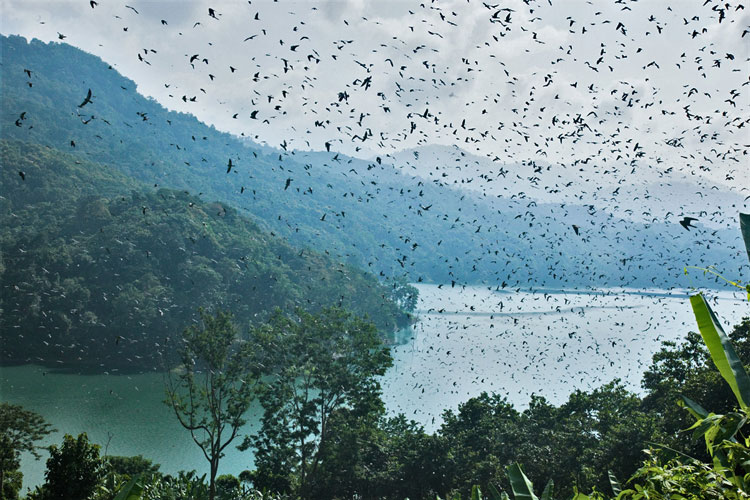 |
| Long-tailed Rosefinch Moscow VN98972 in Nenjiang, China © Nenjiang Bird Ringers |
After ringing around 15.000 birds during the last three years at Muraviovka Park, the first individual was now controlled outside of our study range!
At Nenjiang in the Heilongjiang province in China a ringing scheme was started by Chinese and Swedish ringers in 2013. Since I knew this, I was waiting for the first re-trap, since their trapping site is located "only" 200 km southwest of Muraviovka Park (which is really not a big distance for Russian standards). But I did not expect, that the first one will be a
Long-tailed Rosefinch - this species is said to be mostly sedentary.
The bird with the ringnumber Moscow VN98972 was caught and ringed within the Amur Bird Project at Muraviovka Park on 26th September 2012, and we re-trapped the probable first-year-bird twice until the 1th of October. We did not trap the bird in spring or autumn 2013. But on 23th October 2013 the bird was controlled by a Chinese ringer at Nenjiang, determined now as an adult female. This bird crossed the Amur river and the Lesser Chingan mountains, but it has to remain unclear if the bird will stay during winter or migrate further. Intense migration of Long-tailed Rosefinches was noticed at Muraviovka Pak every year during the end of September and mid-October as well as during the end of March and the beginning of April, even if at least some birds winter there, too. This record is the first long-distance recovery for the inland population of this species known so far.
One of our birds probably holds the longevity record, too: the male
Long-tailed Rosefinch XP87825 was ringed at Muraviovka Park on 31th October 2009 and re-trapped regularly until the 22nd of July 2013, when the bird was at least four years old.
Such records can only be achieved during long-term projects - so we hope to continue the Amur Bird Project in 2014.
I want to thank Aleksey Antonov, Guo Yumin and the ringers at Nenjiang as well as Muraviovka Park and the Moscow Ringing Centre.
Nachdem wir nun um die 15.000 Vögel in den letzten drei Jahren im Muraviovka Park beringt hatten, wurde es nun endlich Zeit für den ersten Fernfund außerhalb unseres Untersuchungsgebietes!
Bei Nenjiang in der chinesischen Provinz Heilongjiang wurde 2013 ein Beringungsprojekt unter der Leitung von Ornithologen aus China und Schweden gestartet. Seitdem ich davon erfuhr, wartete ich gespannt auf den ersten Wiederfang, da sich der Fangplatz "nur" ungefähr 200 km südwestlich des Muraviovka Parks befindet (was für russische Verhältnisse keine große Entfernung ist). Aber ich hatte nicht erwartet, dass der erste Austausch-Vogel ein
Meisengimpel sein würde - diese Art gilt für gewöhnlich als Standvogel.
Der Vogel mit der Ringnummer Moskau VN98972 wurde im Rahmen des Amur Bird Projects am 26. September 2012 gefangen und beringt und bis zum 1. Oktober 2012 zweimal von uns wiedergefangen. Höchstwahrscheinlich handelte es sich um ein diesjähriges Exemplar. Im Frühling und Herbst 2013 wurde das Individuum nicht im Gebiet nachgewiesen. Doch am 23. Oktober 2013 konnte ein chinesischer Beringer den Vogel in Nenjiang fangen, der nun als adutes Weibchen bestimmt werden konnte. Dieser Meisengimpel hatte also den Amur als auch das Kleine Hinggan-Gebirge überquert, doch ist unklar, ob der Vogel dort bereits sein Winterquartier erreicht hatte oder weiter ziehen wird. Im Muraviovka Park konnten wir starken Meisengimpel-Zug jährlich zwischen Ende September und Mitte Oktober als auch Ende März/Anfang April feststellen. Einige Individuen überwintern jedoch auch im Gebiet. Dieser Nachweis ist der erste Beleg für eine größere Zugstrecke in der kontinentalen Population des Meisengimpels.
Einer unserer Vögel hält vermutlich auch den
Meisengimpel-Altersrekord: das Männchen mit dem Ring XP87825 wurde am 31. Oktober 2009 im Muraviovka Park beringt und von uns regelmäßig kontrolliert, zuletzt am 22. Juli 2013. Der Vogel war zu diesem Zeitpunkt mindestens 4 Jahre alt.
Derartige Nachweise gelingen nur im Rahmen von Langzeit-Studien - und so hoffen wir, das Amur Bird Project auch 2014 weiterführen zu können.
Dank gilt Aleksey Antonov, Guo Yumin und den Beringern in Nenjiang als auch dem Muraviovka Park und der Beringungszentrale Moskau.
 |
Long-tailed Rosefinch Moscow VN98972: shown in the map is the distance
between the place of ringing at Muraviovka Park (26.09.12) and the site
were the bird was re-trapped at Nenjiang (23.10.13), the yellow line
indicates the Chinese-Russian border
|
Another picture of the Long-tailed Rosefinch in China can be found
here on the blog of the Swedish ringers in Beidaihe.
Ein weiteres Foto von dem Meisengimpel in China kann man
hier im Blog der schwedischen Beringer in Beidaihe finden.
// Wieland



